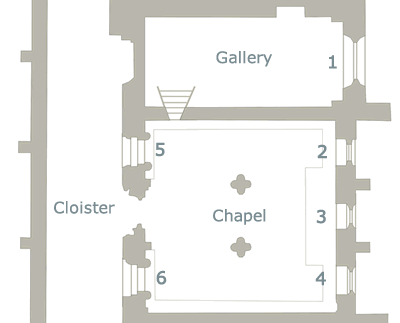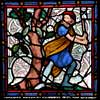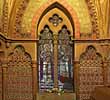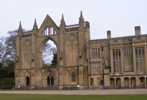For this church:    |
|
 |
Key to Glass |
Within the Chapel proper and the Gallery there are six stained glass windows, four in the external wall and two flanking the door between the Chapel and the East Cloister.
All the windows are by Hardman and Company. John Hardman (1767–1844) of Handsworth, was the head of a family business designing and manufacturing metalwork. Augustus Pugin commissioned work from Hardman and then in 1845 urged him to enter the burgeoning industry of stained glass manufacture. He was joined by his nephew, John Hardman Powell, who married Pugin’s daughter Anne in 1850. Powell became the chief designer from about 1849.
Charles Alban Buckler (1824-1905) was the architect responsible for the restoration and redecoration of the Chapel, after Newstead Abbey had been bought by Mr and Mrs Webb. Buckler in effect created the splendid Chapel in use for regular public worship that we see today. Buckler came from a well-known family of topographical draughtsmen, some of whom, including his father John Chessell Buckler (1793-1894) practised as architects.
The surviving Hardman order books reveal that Buckler ordered stained glass windows from the firm on 16th and 17th June 1862 shortly after his first visit to Newstead and receiving the commission. His communication states that he was ordering them ‘on behalf of the patron W H (sic) Webb’. A memorial window to Colonel Wildman was ordered separately in March 1864, to be paid for by Mrs Webb.
The subject matter and detailed designs were to be provided by C A Buckler. Buckler redesigned the tracery of the three windows in the east wall of the chapel to provide them with more of a 13th century character, compared with the Georgian perpendicular tracery proposed by John Shaw in 1829.
 Window 2 Window 2 |
 Window 3 Window 3 |
 Window 4 Window 4 |
The three Windows 2, 3 and 4 are of similar design. In the quatrefoil opening in the plate tracery at the top of each window, an angel presides, holding a narrow inscribed scroll and closing the composition over the pointed trefoils of the lights below. Each light contains a formal design based on intersecting circles, above and below a pair of niches with rich architectural canopies, over scenes which relate across each pair of lights.
The subjects are:
Window 2: ‘the penance of Henry II’
Window 3: ‘The Crucifixion’
Window 4: ‘Suffer Little Children to come unto Me.’
 Window 1 Window 1 |
 Building Buildingconstruction |
 Shrine being Shrine beingsetup |
 Stone mason Stone mason |
 Woodcutter Woodcutter |
 Colonel Wildman's arms Colonel Wildman's armsflanked by 'W' monograms |
The fourth window in the east wall (Window 1) is of different design. It was dedicated by Mr and Mrs Webb to Colonel Wildman and was paid for by Mrs Webb. A brass plaque at the bottom of the window reads:
|
Nearly two years after Hardman had supplied the glass for Windows 2, 3 and 4, they received a further order for Window 1. The order is dated 24 March 1864. Colonel Wildman’s arms are in the top trefoil, flanked by ‘W’ monograms in each of the pointed trefoils on either side. The design of the two squares, either side of the central mullion, is particularly fine, the artist having captured the vigour and movement of a stone-mason at work on the left, and a woodcutter on the right. These bring similar images from medieval glass to mind.
Above the squares, two panels appear to celebrate the construction of a religious building. On the left, a regal figure (perhaps Henry II) appears to be showing a plan to one of the builders, whilst a toiling figure carries a heavy load up to the top of the scaffolding. In the right hand panel a shrine is being set up, with the same regal figure in evidence. The tradition that Henry II established the Priory of Newstead as a penance for precipitating the murder of Thomas Becket is thereby reinforced.
 Window 5 Window 5 |
 Window 5 Window 5 |
 Window 6 Window 6 |
 Window 6 Window 6 |
The remaining two windows in the chapel (Windows 5 and 6) were installed some 25 years later in 1889, following the death of Mrs Webb. On either side of the Chapel door, and with restricted light coming through from the Cloister beyond, the glass of each window lies between a central column, with plate tracery above, on each of the chapel and cloister sides. Both windows have figures either side of central columns, in gothic canopies, with foliated patterns in the quatrefoils above.
In Window 5, there are representations of the Christian Virtues: Saint Faith, with her red martyr’s halo, stands opposite a figure representing Hope or Grace, whose symbol is an anchor, which she holds.
In Window 6, to the south of the door, an angel on the left holds a child (one of Mrs Webb’s children – Wilfred – died in 1861 aged 4 months) whilst an angel on the right plays a harp.
The provenance of these latter two windows is not documented, but the details of the canopies and halos when compared with Buckler’s restoration of the east window in the Fitzalan Chapel in Arundel Castle (1891) and Buckler’s known contact with the Webb family in the 1890’s, points strongly to both Window 5 and Window 6 being by Hardman.
Both windows carry wording at the foot, which reads across both windows from left to right (and therefore starts on Window 6):
God is Love; Rejoice Always; Sanctified by Faith; Hope is God In loving memory of Emelia Jane Webb who died December 28th 1889 at Bairstfontrin South Africa. |






